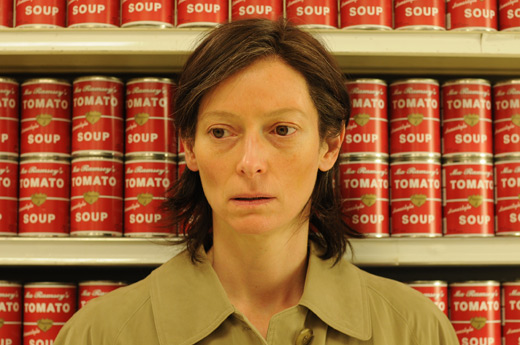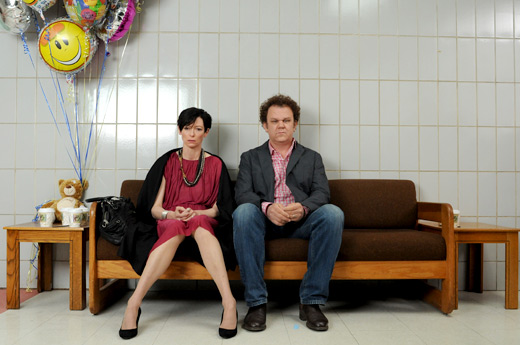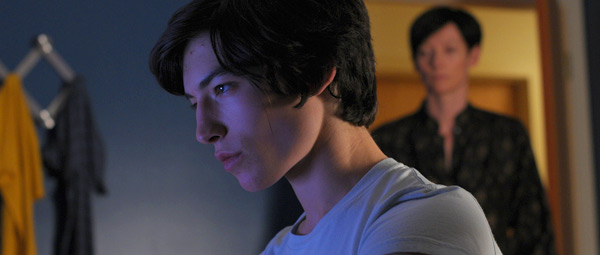We Need to Talk About Kevin Combines 'Scope, DSLR Footage to Dreamlike Effect
My background as a still photographer has had more impact. They’re very different media. When I was a still photographer, I would choose a subject and document it. It’s like being a director. When I went to film school, it was because I saw Maya Deren’s “Meshes of the Afternoon,” which is a silent, surreal film. I thought I would go to the Royal College to become a photographer. Having the technical skills I do is useful. I think very visually. I also think in sound. Some of the best filmmakers have been photographers, like Stanley Kubrick. People who know my still work can recognize it in my films.
Have you continued to work as a photographer?
Some of the cameras I like aren’t being made anymore. You can’t even get Polaroids anymore. I’m better with mechanical cameras. I’m lucky enough to have been taught old school, where you still had a print and went into the labs. What was wonderful about that is you see it with very fresh eyes. I tried getting black-and-white stock developed recently, and the lab didn’t know how.

Tilda Swinton
Did you ever consider shooting all of We Need to Talk About Kevin digitally?
We did shoot 5D and Cinemascope. It takes in a lot of information. [The 5D is] the first digital camera I quite like. I don’t like the RED. Steven Soderbergh will kill me for that. Sometimes people think “digital makes it quicker,” but the time you take it to make it look like film slows it down. Shooting anamorphic was fantastic. I’ve never done it before. That was a little treat. I saw the film as a domestic horror film, or akin to Sergio Leone’s Westerns. I used the wide frame instead of close-ups and two-shots. Some producers get frightened when you tell them you’re shooting Cinemascope. The Halloween scene is in 5D. For me, 5D looks better at night. The rest is shot in 35mm. We mixed it up, which is an unusual thing to do, but I think it works.
Did the writing process influence your visual approach?
Of course. My images are written into my script. I also went to this place called the School of Sounds in London, which endorses writing sounds as well as images. I started thinking about it quite early. Me and my sound designer, Paul Davis, had thought a lot about sounds over a few years. All the colors, even the cuts, were pre-planned. We had a wonderful editor [Joe Bini] who’s worked with Werner Herzog.
The opening 20 minutes are very impressionistic and disorienting. At what point did you decide to adopt such an unusual approach?
The film’s nonlinear, and it’s a memory piece. I saw it like a puzzle or Rubik’s Cube. Every day that Eva stays in the same place is a flagellation, a punishment. People know what her son has done. I thought about her reliving this nightmare, her past and how reliable her memory is. It took us four years to write the script, although that’s partially due to financial issues.
The film is often very colorful, but it’s also set in a drab suburban environment. Was it hard to get a balance between those two elements?
Again, that was a decision I made quite early on. With the suburban house, I wanted it to feel very isolated. It’s an awful, confined space which Eva feels she can never escape. Her present-day reality is very down. She chooses to live in an alienating place. That’s all incorporated into the color scheme.

Swinton and John C. Reilly
The colors red and white tend to dominate the film. Is there any intentional symbolism to them?
No, I think sometimes people overread that. Hitchcock used color in a very creative way. I tried to use red in a way that Eva is reminded of her son’s crime. Red dominates because someone vandalizes her house with red paint, and she’s forced to clean it up. It’s not a violent movie – you don’t see on-screen violence. That’s more terrifying in a way. Maybe the violence comes through in the colors.
Kevin is chaotic and eventually turns violent, but there’s something creative about his behavior.
Ramsay: I saw him as an artist. There’s a line in the book where Kevin says to his mom, “When you’re putting on a show, you don’t shoot the audience.” There’s a way in which his murder is his work of art, albeit an extreme and negative work.
The production design struck me. It seemed influenced by Abstract Expressionist painting.
I wanted to keep the wallpaper. It was so creative. It was done by Jasper, the actor himself, not a production designer. It was a bit childlike and like Jackson Pollock. Eva likes it and leaves it that way for the rest of the movie.
How smoothly did you work with {co-screenwriter} Rory Kinnear on your writing?
A company called Summit, who produced Twilight, danced around the project. They got an unsolicited draft. They seemed serious for a year and would invest 12 million pounds. It seemed too good to be true, but my dad was dying, so I was distracted. Then, that money fell through and the recession kicked in. I had to reimagine the film on half the budget. I took it to BBC Films. They thought the book was too dark, but they liked me as a filmmaker and believed in me. They’ve supported me in the past and been very good to me.
Did you look at other films about American suburbia?
I like films by first-time European filmmakers who come to the U.S.: Wim Wenders, Milos Forman. They look at it with fresh eyes, as if you came to Scotland. It’s a bit like being a photographer again. I mostly watch old films.
Are you particularly interested in literary adaptations?
After the Lonely Bones adaptation fell through, I told myself I was never going to do another adaptation. We Need to Talk About Kevin came to me through my agent. He reads stuff all the time, although mostly classics. I wanted to make the structure of the film very compelling, like the novel. You know from the opening scene that something bad will happen. It draws you along. I wrote Ratcatcher myself. Morvern Callar is very different from the book. The Lovely Bones would have been very different. The book is in letters, but I think it retains the same spirit.
Did you ever feel self-conscious about dealing with the extreme emotions of We Need to Talk About Kevin? Female filmmakers usually aren’t encouraged to express this level of anger.
I felt like killing a few people after my last experience! It had been nine years since my last film. I need to be brave and bold. I got burned because people were trying to make The Lovely Bones into something else. There’s a lot of great filmmakers who are still doing original work, but there should be more of them. I think people are reacting against being bored and spoon-fed and patronized.
We Need to Talk About Kevin opens Friday, January 13, in New York and Friday, January 20, in Los Angeles, with a platform rollout to follow.
Photos courtesy Oscilloscope Laboratories
Did you enjoy this article? Sign up to receive the StudioDaily Fix eletter containing the latest stories, including news, videos, interviews, reviews and more.









